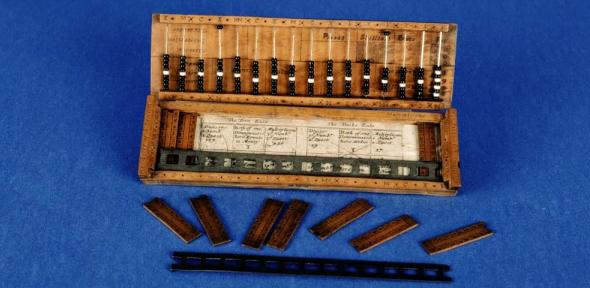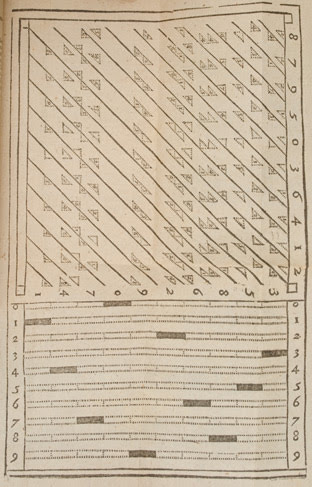Because Napier's bones, also called 'speaking rods', largely eliminated the mental arithmetic required by large calculations, they became a popular tool in a society where few were educated enough to perform complex arithmetic.
The linguist and royal Master of the Ceremonies to Charles I and II, Sir Charles Cotterell (1612?-1702) designed a device combining Napier's bones with a simple abacus arranged as a portable compendium (Image 3, above). It came along with a text which advertised itself as
"[s]o easy a way, to learn and use that Art,/That even those who can neither write nor/Read, have been thereby taught all the general/Parts of it."(1)
Meant as a didactic tool, the book also catered to "skilful Artists" who wished to use the very same rods to calculate square and cube roots. Even into the 20th century, Napier's bones were an educational resource shown to students to help them think about breaking big calculations into smaller parts.
The first adding machine?
A popular way of arranging Napier's bones as rolling rods may have inspired the very first calculating machine. In 1617, the astronomer Johannes Kepler (1571-1630) discussed Napier's discoveries with his Tübingen colleague Wilhelm Schickard (1592-1635). A few years later, in 1623, Schickard wrote to Kepler describing a machine he had devised using rods and a set of gears that could mechanically carry or borrow numbers during addition and subtraction.
Unfortunately, the machine Schickard commissioned to be built for Kepler was destroyed in a fire, and Schickard's own has never been found, so only drawings and descriptions can tell us about this device. Whether Schickard deserves credit as the inventor of the first mechanical calculator, or whether that credit should go to Blaise Pascal, who invented a working machine in 1642, is a debate that still continues.
References
- Quoted in: D. Bryden, 'A Didactic Introduction to Arithmetic, Sir Charles Cotterell's 'Instrument for Arithmeticke' of 1667 (1973), History of Education 2, 1 (1973) pp. 5-18, p. 5.
Mikey McGovern
Mikey McGovern, 'John Napier's calculating tools', Explore Whipple Collections, Whipple Museum of the History of Science, University of Cambridge




